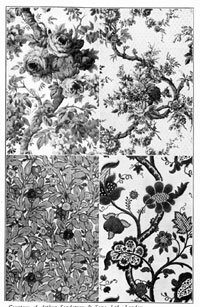Ornament
ORNAMENT is that which adorns, and embellishes. It gives variety and richness to the ornamented surfaces, and is, no less than plainness, essential to beauty in the decoration of houses. Without ornament a room would inevitably be monotonous and uninteresting. It must, however, be good ornament, and there must not be too much of it.
Ornament exists to enrich and beautify constructional forms, and it is good ornament only when it appears to be not a fortuitous and unrelated addition to those forms, but an integral, organic part of them, as much a matter of growth as the markings of a butterfly or the plumage of a bird. In an accurate sense ornament can have no independent existence. It is always a decoration or embellishment, and it is significant only in association with some useful or constructional form that it is fitted to adorn. The ornament employed in the design of the chair shown in Figure 10 is good ornament because it embellishes and emphasizes artistically the constructional lines of the back and legs. When on the contrary ornament, instead of being content to adorn, seeks to substitute itself for structural forms, as in the Barocco chair shown in Figure 49, it becomes bad ornament and infinitely worse than none at all.

FIGURE 49.- Ornament substituted for or exalted at the expense of structure makes beauty impossible.
All ornament, whatever its character, can be traced to an origin in either natural or geometrical forms. The earliest ornament was almost wholly geometrical, and consisted chiefly in simple arrangements of straight, curved and zigzag lines, or rhythmically repeated circles, scrolls, squares and triangles. With advancing culture and increasing technical skill primitive man learned to look to nature for his ornament. Animal and plant forms were drawn from the natural world, and more and more employed in the embellishment of arms, vessels and wall surfaces.
Natural forms employed as the basis of ornamental design may be used by the designer in either of two ways. When such a form is accurately copied, so that both its details and its peculiar order of growth or development are imitated, the ornament is said to be naturalistic. When the ornament simply reproduces the typical form of the natural object, changing its details and coloring and disregarding its natural order of growth, it is said to be conventional. The wall papers pictured in Plate XIV show ornament drawn from nature, in varying degrees of conventionalization. The Greek honeysuckle or anthemion is purely conventional ornament. In the great ornamental styles the details have for the most part been taken from nature, but treated conventionally. There may be a fairly close imitation of natural forms in the parts of an ornamental design, but never of the natural order of growth; for it is in the nature of good ornament to fit the structural form of the object it adorns, and this is possible only when the natural order of growth is disregarded.

PLATE XIV.- Wall papers illustrating varying degrees of conventionalization in ornament.
However, the person of uncultivated taste has a marked predilection for the mere imitation of natural forms, and in all periods of poor taste naturalistic ornament is very common. Forty years ago, in what might be called the iron stag age of American home-making, we were graining wood and wall paper to imitate marble, hanging hair wreaths and wax flowers, glass-encased, on our walls, and weaving the images of cats and dogs, to say nothing of roses and holly-hocks, into our rugs. In England and Germany things were as bad or worse; and even in France naturalistic roses were woven into the Aubusson and Savonnerie carpets of the old regime, while it remained for a Frenchman of a later date to design a porte-cure-dents, or toothpick holder, carved or cast in the form of a turkey gobbler, with the toothpicks tastefully disposed fan-wise to form the tail. To-day naturalistic ornament is largely confined to floor coverings, wall papers, drapery stuffs and hand-painted china, and while a lot of it is to be seen in the shops, and more of it in the homes of unsophisticated folk, no one is compelled to buy it; for so notable has been the progress of American manufacturers during the past ten or fifteen years that it is possible to find properly conventionalized ornament in any field, and at any price.
 "Finally! Step-by-Step Guidebooks Show
"Finally! Step-by-Step Guidebooks Show